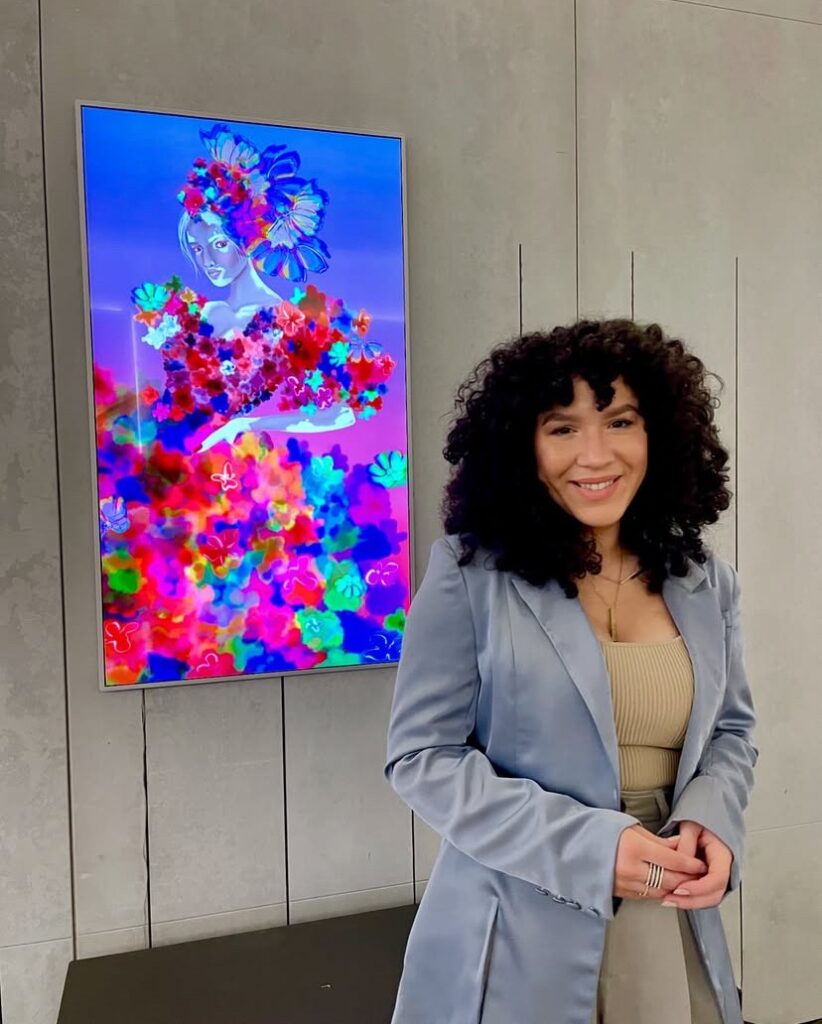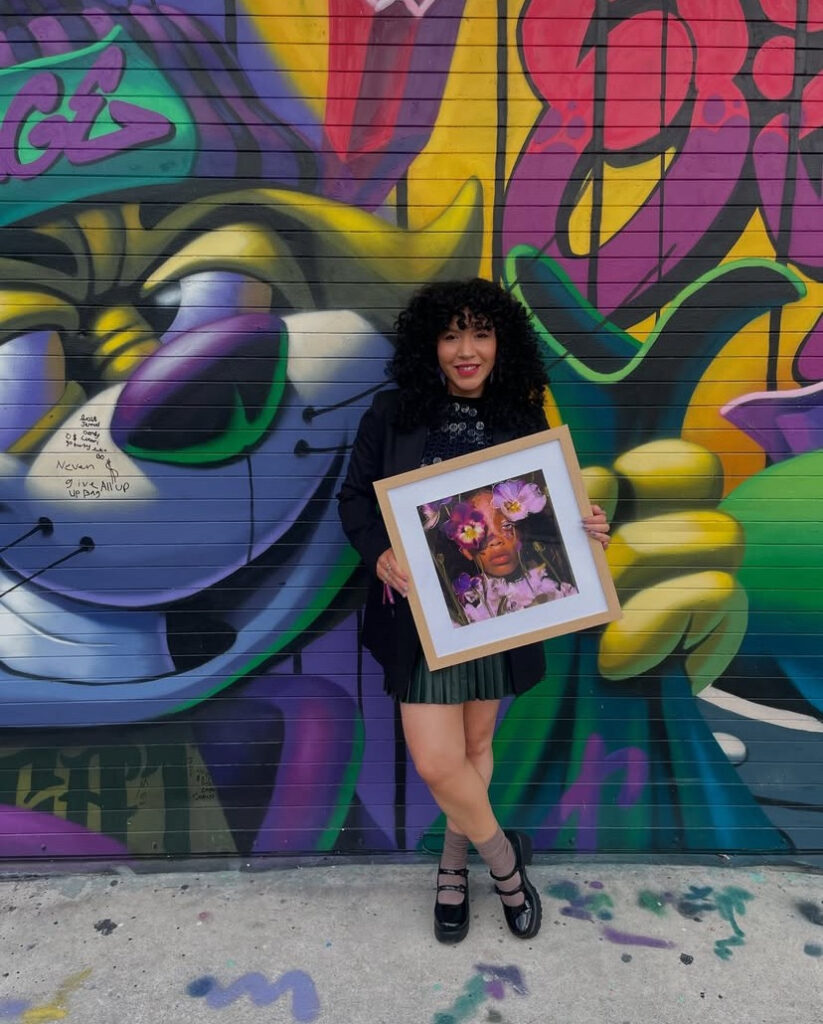Digital Artist Wildy Martinez on Fighting for an Inclusive AI Future—With Vitiligo

Wildy Martinez is a creative force—part digital artist, part fashion storyteller, and full-time advocate for underrepresented voices. And now, she’s also the digital artist partnering with Living Dappled to increase representation of vitiligo—and fund mental health resources for women with the condition. Here’s her story.
Meet Wildy
A Dominican-American woman raised in Washington Heights, New York, Wildy grew up surrounded by the vibrancy of culture, family, and faith. After nearly 20 years designing for fashion houses like BCBG and Elie Tahari, she pivoted her creative energy into the digital space following the pandemic—launching into the world of NFTs, artificial intelligence, and advocacy for skin diversity and inclusion.
What started as experimentation quickly turned into innovation. When Wildy released Wildflower 38, a fashion illustration that included her vitiligo for the first time, the work went viral—marking a personal and professional turning point. Since then, she’s been on a mission to make sure women like her are not only seen but also preserved in the future of art and technology. From training her own AI models to combat a lack of skin diversity, to becoming the first AI fashion designer with vitiligo to be featured in Vogue and Times Square, Wildy is pushing the boundaries of what’s possible in fashion, tech, and representation.
In this candid conversation with Living Dappled Founder Erika Page, Wildy opens up about her journey from self-doubt to visibility, how digital art changed her life, and why she’s committed to making space for women of color—and women with vitiligo—in the tech-powered future of creativity.
We sat down with Wildy to talk about her creative path, how her skin condition shaped her art, and her new collaboration with Living Dappled—a celebration of wildflowers, women, and vitiligo.

Q&A with Wildy Martinez
The following is an edited edition of a live conversation between Living Dappled Founder Erika Page and digital artist Wildy Martinez.
Erika: Wildy, let’s start with who you are outside of your work.
Wildy: I’m a mom to an amazing little boy, a Dominican New Yorker raised in Washington Heights. Growing up, I was surrounded by family—my grandmother, aunts, and uncles all lived in our building. It was a true generational home, and even though we lived through the drug crises of the ’80s and ’90s, I felt safe because of that strong cultural and family foundation. Now I live in North Carolina, love being in nature, drinking coffee, and being part of a faith-filled community.
Erika: What inspired your creative journey?
Wildy: I knew I wanted to be a fashion designer since I was six. I saw mannequins in a store window and told my mom, “I want to make those dresses.” That identity stuck—I was always “the designer” in my family. I studied fashion in high school and later attended FIT, where I thrived. I went on to work in the industry for nearly 20 years, designing everything from athleisure to activewear for major brands.
Erika: So what led you from fashion to digital art?
Wildy: When COVID hit, I lost my job and had to start over. I’d been freelancing and doing advocacy work through fashion, including working with sex trafficking survivors in Nepal. But after losing my full-time role, I started looking into NFTs. I took online courses and went down the rabbit hole learning about blockchain, ownership, and royalties for artists. I posted some artwork I had created during that time—and then something wild happened. One piece sold overnight and got flipped multiple times in the marketplace. I woke up with money in my account. It was the first time my art truly paid me.
Erika: That’s incredible. Tell me about your iconic piece, Wildflower 38.
Wildy: That piece changed everything. I created it for my 38th birthday—it was a fashion illustration, and for the first time, I added vitiligo to the figure’s skin. That was me coming out with my story. I’d hidden my vitiligo for 15 years. When I posted it, a collector reached out immediately and told me she’d been waiting to buy it. It went viral in the NFT space. But more importantly, it gave me a voice. Suddenly, I was getting DMs from moms of kids with vitiligo, and women who finally saw themselves in my work.
Erika: That’s such an inspiring story for other women with vitiligo who fear what might happen if they let people see their skin. You’ve now created a career out of AI and fashion—how did that happen?
Wildy: I started experimenting with AI and was blown away by how I could create entire new worlds that existed in my imagination. It was like fashion storytelling unlocked on a new level. A friend encouraged me to apply to AI Fashion Week, which is a global competition. I didn’t make the finals the first year, but it opened a door. I started training my own AI model—using my artwork and photos to teach the model what vitiligo looks like. Because honestly, AI systems weren’t recognizing it. If I typed in “doctor,” I’d get a white man. No women of color, no vitiligo, no skin diversity.
Erika: That’s such an important problem to address.
Wildy: Yes! I realized the people training these models are mostly men, and the datasets weren’t built for us. So I took it into my own hands. I trained my own AI model and became one of the top 20 in the competition the following year. I was the only designer using a vitiligo-trained AI model—and I made it into Vogue. That moment was huge. I’ve since shown my work in Times Square, NFT NYC, Paris, London… it’s been surreal.
Erika: And you recently created something for the Bitcoin blockchain?
Wildy: Yes! It’s a piece called Bit-Tiligo, my first artwork inscribed directly on Bitcoin as an ordinal. That means it’s preserved forever. For me, it’s not just about art—it’s about legacy. Historically, women’s art has been erased or stolen. With blockchain, my son will be able to access my work, even when I’m gone. It’s incorruptible. That means everything to me.
Erika: You’ve also spoken at the United Nations—tell me about that.
Wildy: It was an honor. I was one of 17 women speaking about Web3 and the future of a decentralized internet. I talked about the evolution of fashion and art through blockchain and AI. I later helped moderate a group of women in tech, and we raised funds for young girls in STEM. We even published a book, and all the proceeds go to helping girls who don’t have access to STEM education. So yeah—whether it’s fashion, tech, or advocacy, I try to show up wherever I can.
Erika: Let’s shift gears a little and talk about your journey with vitiligo. Can you take us back to your diagnosis and how it’s shaped your life and work?
Wildy: Absolutely. I first noticed a spot in my early 20s. It went away, so I thought nothing of it. But then it came back—on my hands, my knuckles—and I went to a dermatologist who confirmed it was vitiligo. I didn’t get any emotional support, just a prescription and a “there’s no cure.” That moment was terrifying. I didn’t have tools to process it. So, I did what so many of us do—I covered it. For nearly a decade, I used makeup every day, wore long sleeves, and stayed hidden.
Then I became a mom in 2016. That was the turning point. I couldn’t wear makeup while holding a newborn, and I slowly started to let go of the covering up. When we moved to North Carolina in 2021, it was a fresh start—no one knew me there. I wore a swimsuit in public for the first time. And by 2023, I created a digital art piece that told my story, and I shared it with the world. I was done hiding.
Erika: That’s so powerful. What changed when you stopped hiding?
Wildy: Everything. All the things I had once been told to hide—my curly hair, my brown skin, my vitiligo—became the foundation of my art. And that art is what opened doors for me. The moment I embraced the wildflower in me, I bloomed. And what I’ve learned is this: when you bloom, you attract beauty, life, freedom. Your self-love becomes contagious.
Erika: You often refer to yourself as a wildflower. Can you explain that metaphor?
Wildy: Yes! My brand is called Wildflower Fields. I’ve researched wildflowers that grow in volcanic ash, in deserts—places you’d think are inhospitable. And yet, they bloom. That’s how I see myself, and how I see so many women, especially those with vitiligo. Our spots are unique. No one has the same pattern. We are the real wildflowers of the world. We bloom in unlikely places. There’s a Bible verse I love: “Look at the wildflowers. No one tends to them but me.” That verse reminds me I’ve never been alone. I’ve been growing under God’s care all along.
Erika: And now you’re partnering with Living Dappled—and we’re so grateful. What does that mean to you?
Wildy: It’s everything. For a long time, I was creating on my own. I wasn’t connected to a vitiligo community. I didn’t know Living Dappled existed until recently. But this collaboration—creating art that reflects and uplifts this community—it feels like the partnership I needed for myself. I’m finally combining my passion for art with a cause that’s personal and deeply emotional. It’s healing.

Q&A: Fast Five with Wildy Martinez
What does digital art allow you to say that other mediums don’t?
It lets me build worlds—spaces where I can be fully myself, where beauty is fluid and expansive.
What inspires you as an artist?
I’m inspired by the beauty of nature, and the diverse beauty of people—especially women. When a woman embraces her inner beauty she has a contagious power, and I love trying to capture and share that spark.
How does vitiligo influence your creative work?
It’s infused in everything. My models have it, my color palettes reflect skin tone variations, and my themes explore visibility, transformation, and softness through a lens of lived experience.
What do you want people to take away from your collaboration with Living Dappled?
That our uniqueness is our beauty. That our stories matter. And that art can be a tool for healing and visibility.
What advice would you give to another woman just diagnosed with vitiligo?
You are not broken. You are becoming. Your skin is your story, and when you embrace it, you will bloom in ways you can’t yet imagine.
A patient advocate, editor, and sought-after leader within the vitiligo community, Erika Page is also the Founder and CEO of Living Dappled. After getting vitiligo at the age of seven, she lost 100% of her skin’s pigment over 25 years. She fought her own mental and emotional battle to overcome her insecurities and embrace the skin she was in and today seeks to help other women reclaim their lives with this condition.


